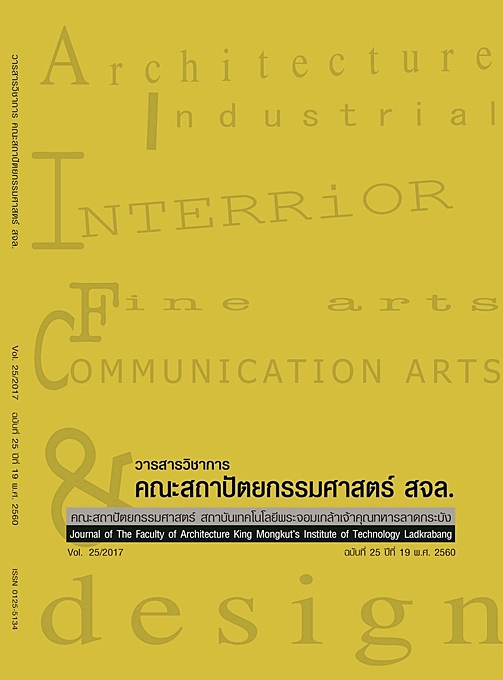โครงข่ายชุมชนบนการวางผังเมืองสมัยใหม่ จากการศึกษาเชิงเปรียบระหว่าง ชุมชนโคยยามะ จังหวัดเกียวโต และชุมชนบนถนนนิมมานเหมินทร์ จังหวัดเชียงใหม่
Main Article Content
Abstract
บทคัดย่อ
การวางผังเมืองสมัยใหม่ (Modern City Planning) เป็นแนวคิดการพัฒนาพื้นที่เมืองในศตวรรษที่ 20 ด้วยการสร้างศูนยกลางและเชื่อมต่อพื้นที่เมืองด้วยโครงข่ายของถนน นำไปสู่การจัดสรรพื้นที่ด้วยระบบตารางและรูปทรงเรขาคณติ ที่ทำให้ผู้คนในพื้นที่ต้องปรับตัวและการดำรงชีวิตอยู่ตามลักษณะทางกายภาพของพื้นที่เมืองตามที่รัฐจัดสรรให้ ผู้วิจัยสนใจความสัมพันธ์ของชุมชนเมืองที่ปรากฏกิจกรรมและวิถีชีวิตของคนในพื้นที่ผ่านโครงข่ายชุมชน 2 ชุมชน คือ ชุมชนแรกที่เกิดจากการวางผังชุมชนในอดีตที่มีโครงข่ายของชุมชนที่เชื่อมโยงกับศาสนสถานและมีกิจกรรมทางวัฒนธรรมของคนในพื้นที่ ผ่านการศึกษาชุมชนโคยยามะ (Koiyama) ในจังหวัดเกียวโต ที่สะท้อนการดำรงอยู่ของโครงข่ายชุมชนที่ดำรงอยู่แม้ภูมิทัศน์ของเมืองได้ถูกพัฒนาไปเป็นเมืองสมัยใหม่และชุมชนที่สอง ที่เกิดจากการพัฒนาพื้นที่เมืองในประเทศที่กำลังพัฒนาด้วยแนวคิดเมืองสมัยใหม่การพัฒนาบนพื้นที่เมืองใหม่ที่ไม่ได้มีรองร่อยของโครงข่ายชุมขนที่เป็นชุมชนทางศาสนาใดๆ แต่คนในพื้นที่เองได้เริ่มสร้างภาพของชุมชนและโครงข่ายของชุมชนขึ้นมาเอง ผ่านกรณีศึกษาถนนนิมมานเหมินทร์ จังหวัดเชียงใหม่ บทความนี้อ้างอิงทฤษฎีแนวคิดความเป็นเพื่อนบ้าน (Neighborhood Concept) ของแคลเรนซ์ เพอรี่ ที่อธิบายความเป็นเพื่อนบ้านจากการพึ่งพากันระหว่าง 2 ปัจจัย คือ การออกแบบพื้นที่ทางกายภาพ และปฏิสัมพันธ์ทางสังคม ที่ผู้วิจัยใช้เป็นหัวข้อของการเก็บและวิเคราะห์ข้อมูลโครงข่ายของชุมชน นำไปสู่การอธิบายคุณลักษณะของชุมชนจากรูปแบบความสัมพันธ์ของคนในชุมชน และวิธีการของการจัดการกิจกรรมของชุมชนที่เกิดขึ้น เพื่อพัฒนาไปสู่เมืองสร้างสรรค์ ที่ชุมชนสามารถขับเคลื่อนชุมชนด้วยตัวเองผ่านการดำเนินกิจกรรมของชุมชน
คำสำคัญ : พื้นที่เมืองสมัยใหม่ โครงข่ายชุมชน โครงข่ายชุมชน เมืองสร้างสรรค์
Abstract
An idea of “Modern city planning” has been pushed and mainly been strategy for urban development and management at the turn of the 20th century. This development aims to set a center of city and spread out with street network. The urbanization leads the city to real estate management by grid system and geometric shape. Without studying on old community, this development has undeniably effected to the way of life and old community area which is following to government strategy. This article scopes on two types of relative communities on modern city planning. First community is “Koiyama” community in Kyoto city where was established with Koiyama shrine and has still maintained cultural event nowadays. Even the townscape in this community has already turn to modern city. Second community is “Nimmanhaemin” community in Chiang Mai city where was originally a field and has been developed with modern city planning. Now it turns to an important commercial area but also appears community events which are organized by locals themselves. This article mainly refers to Clarence Perry’s “Neighborhood concept” which is an urban management concept to understand people centered community by 2 essences; physic design and social interaction. The objection is to analyze characteristics of community networks and to develop those community networks towards creative city.
Keywords: Modern City Planning, Community Network, Neighborhood Network, Creative City
Article Details
This work is licensed under a Creative Commons Attribution-NonCommercial-ShareAlike 4.0 International License.
Copyright Transfer Statement
The copyright of this article is transferred to Journal of The Faculty of Architecture King Mongkut's Institute of Technology Ladkrabang with effect if and when the article is accepted for publication. The copyright transfer covers the exclusive right to reproduce and distribute the article, including reprints, translations, photographic reproductions, electronic form (offline, online) or any other reproductions of similar nature.
The author warrants that this contribution is original and that he/she has full power to make this grant. The author signs for and accepts responsibility for releasing this material on behalf of any and all co-authors.


